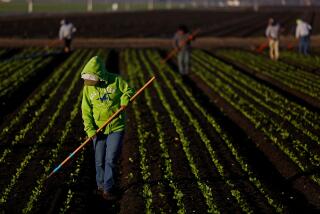It’s Time to Kill This Sacred Cow : Farm subsidies may be on the chopping block, at long last
- Share via
Will Congress do the right thing and end, at long last, America’s politically sacred farm subsidies? The Senate moved in that direction Wednesday when it passed legislation to eliminate the 60-year-old policies, which, among other things, pay farmers not to plant certain crops and subsidize production of others. Backers had a hard time getting the historic changes through the Senate, and it will be no easier in the House, which will take up its version of the farm bill when it returns from recess Feb. 26.
But enough is enough. The antiquated protections put in place during the Depression work against the needs and opportunities of today’s global market, in which new buyers are coming up in Asia, Latin America and elsewhere. The changes in the Senate bill are intended to give the farmers flexibility to accommodate market forces not only at home but abroad.
The Senate’s bill, entitled “Free to Farm,” would, for the first time, remove farmers from a system that supports their income with direct payments whenever market prices drop to unprofitable levels. The proposed new payment system is designed to wean producers off their years of dependence on subsidies. They would be given fixed payments instead of subsidies based on fluctuating market prices, and the payments would gradually decline over the next seven years.
Farmers would also gain some flexibility over what crops they could plant and how many acres they cultivate. The bill’s supporters say more land would be planted, resulting in larger harvests and a steady increase in American food exports if they were price-competitive.
The U.S. program to support farm prices began in the 1920s when farmers suffered a downturn in both the volume and value of their export crops. In 1924, Congress imposed a two-year plan that limited the supply of crops to the domestic market in order to drive up farm prices. Any surplus would then be dumped on foreign markets. Farm prices resumed their downward spiral after the stock market crash of 1929, falling more than 50% in three years and sending American farm country into a tailspin.
The federal government responded by buying surplus crops but in the end did not have enough money to prop up prices. On top of that, Congress passed the Smoot-Hawley Tariff Act of 1930, which raised tariffs to an all-time high. The American move to prohibitive protectionism set off similar moves around the world, and U.S. farm prices tumbled further. In 1933, Congress put in place the system that essentially exists today: government income and price supports and subsidies for farmers in exchange for keeping acreage, mostly for wheat, corn and cotton, out of production. Despite federal attempts to control production, improved farm technology vastly boosted production per acre. Critics of the controlled system point out that benefits of the income and price support programs have increasingly flowed to fewer farmers on larger farms with better technology.
Farmers have been able--ironically, given the origins of the farm programs--to sell an increasing volume of their crops to other countries. Over the last decade, federal farm payments have declined in part because of increasing export sales and the elimination of price subsidies on mohair, wool and honey because of deficit pressures.
The Senate bill is far from perfect. It does not block payment of fixed subsidies to farmers who decide not to plant fields at all. And peanuts, sugar and dairy producers escaped the ratcheting down and apparently would maintain an extraordinary degree of protection.
This will be a heavily debated issue in the House. Why should these agriculture categories not be subject to the same treatment as other crops? Peanut butter already is expensive for consumers; why should they pay twice by subsidizing peanut farmers?
From California’s perspective, the farm bill would not affect most agricultural production. Although California is the nation’s largest agricultural state, accounting for more than 10%, or $20 billion, of the nation’s annual farm production, it receives only about 2% of federal farm payments. California’s vegetable, fruit, nut and livestock industries have never been involved in government farm programs, according to the California Farm Bureau Federation, the state’s largest farm group.
Passage of the farm bill in the Senate pulled together an unusual grouping of liberal Democrats and free-market Republicans. The federal government currently pays about $11 billion a year in subsidies. Ending farm subsidies as we know them would benefit farmers and consumers in the long run.
(BEGIN TEXT OF INFOBOX / INFOGRAPHIC)
Farm Payments
Federal outlays to farmers in selected states:
1994 Totals:
California: $272,782,556
Iowa: $732,667,112
Minnesota: $622,325,313
Nebraska: $346,672,768
North Dakota: $456,194,170
Texas: $858,628,911
Source: U.S. Department of Agriculture
More to Read
Get the L.A. Times Politics newsletter
Deeply reported insights into legislation, politics and policy from Sacramento, Washington and beyond. In your inbox three times per week.
You may occasionally receive promotional content from the Los Angeles Times.










